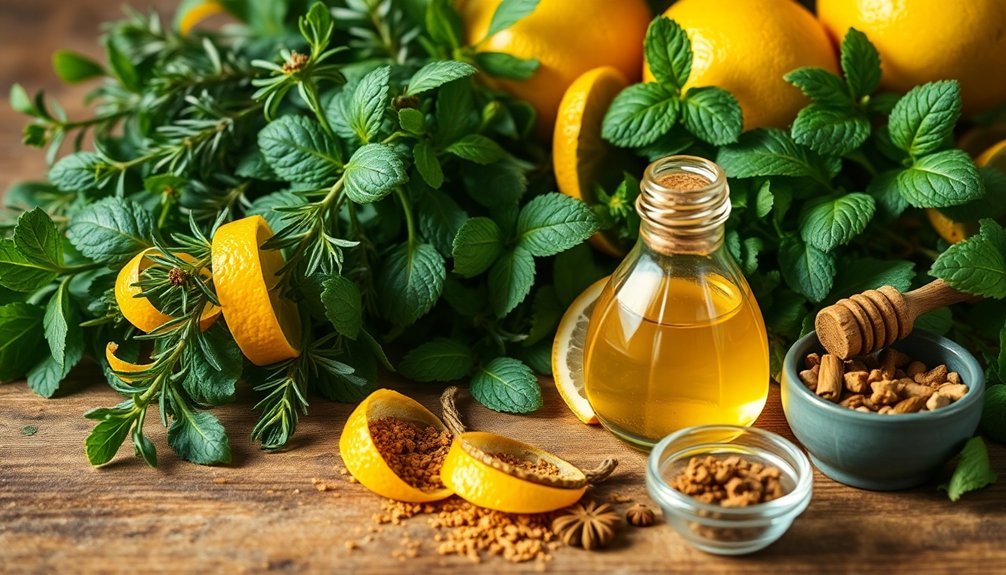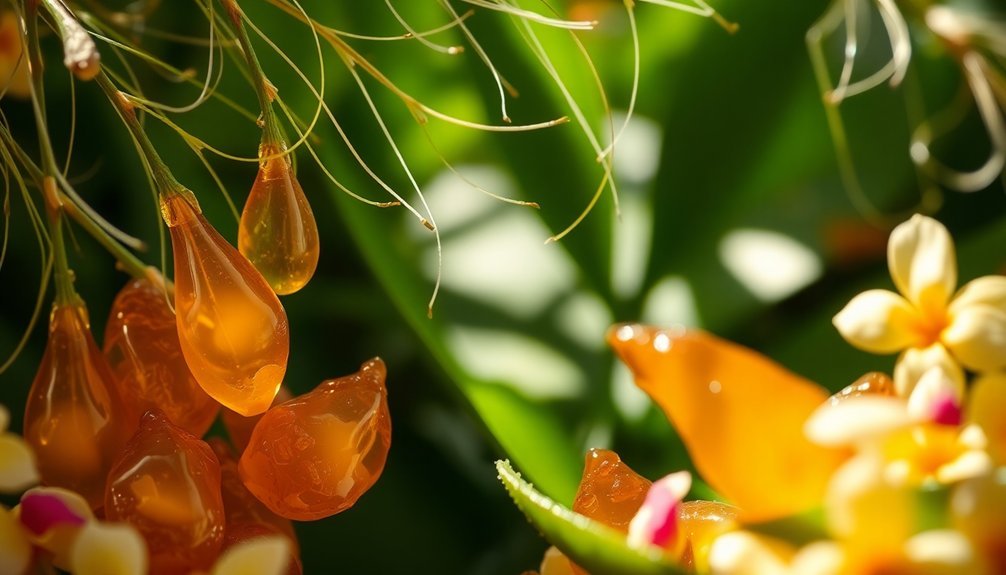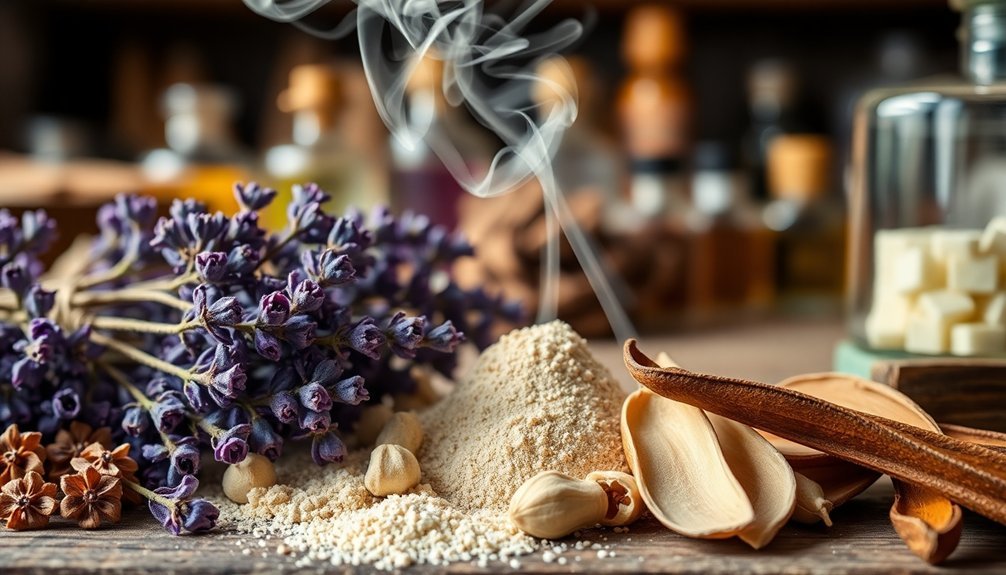You'll need fragrance fixatives to make your perfumes last longer and smell better throughout the day. Natural kitchen ingredients like vanilla and black pepper can effectively anchor lighter scents, while essential oils like patchouli and vetiver provide rich base notes that stabilize the entire composition. The right fixative concentration (typically 3-5%) helps control evaporation rates and maintains your fragrance's character. Discover how these simple ingredients can transform your homemade scents into lasting creations.
Natural Kitchen Ingredients That Lock in Scents

While commercial fixatives can be expensive and hard to source, you'll find several effective fragrance-binding ingredients right in your kitchen cabinet. Your best natural option is vanilla, which not only adds its signature sweet, creamy aroma but also helps lock in other scents.
The rising disposable income of consumers has made experimenting with home fragrance creation more accessible than ever before. You'll find it works especially well in blends that need staying power. If you're creating home fragrances, don't overlook common kitchen spices that double as fixatives.
Black pepper pairs wonderfully with frankincense, creating a warm, spicy base that anchors lighter scents. For a deeper, more complex aroma, try combining these kitchen staples with sandalwood or patchouli oils.
These natural ingredients won't just add depth to your fragrance – they'll help it last longer while keeping your blend completely natural and sustainable.
Essential Oils With Fixing Properties
You'll find several essential oils that naturally extend the life of your home fragrances, with patchouli, vetiver, and sandalwood serving as powerful base notes that anchor lighter scents.
Resinous oils like frankincense and myrrh offer excellent fixing properties while adding their own rich, warm undertones to your fragrance blends. These specialty oils help create balanced fragrance profiles that maintain their character throughout the day.
Woody aromatics such as cedarwood and styrax not only help stabilize volatile top notes but also contribute depth and lasting power to your home scent creations.
Natural Base Note Oils
Natural base note oils serve as essential fixatives in home fragrance creation, anchoring lighter scents while contributing their own distinctive aromas.
You'll find these thick, viscous oils playing a vital role in stabilizing your fragrance compositions and extending their longevity. Their highly concentrated nature means only a few drops are needed for lasting impact. When you're crafting home scents, these natural fixatives slow down the evaporation of volatile components while adding depth to your blend.
- Patchouli offers an earthy foundation that deepens lighter fragrances
- Vetiver brings a smoky, woody character perfect for grounding floral blends
- Sandalwood adds a warm, creamy note that enhances oriental compositions
- Cedarwood provides a balsamic stability to volatile top notes
- Geranium contributes floral depth while helping stabilize other scents
These oils seamlessly integrate into your fragrance formulations, creating balanced, long-lasting aromas that evolve beautifully over time.
Resinous Essential Oils
Among the most powerful fixatives in home fragrance creation, resinous essential oils stand out for their remarkable ability to anchor and extend scent compositions.
You'll find four key players in this category: patchouli with its rich earthy notes, frankincense offering warm resinous tones, myrrh providing smoky sweetness, and vetiver delivering deep woody undertones.
These oils work by equalizing vapor pressures among ingredients, which slows down evaporation and stabilizes your fragrance's scent profile. They're particularly effective when you're working with lighter, more volatile notes that need anchoring.
Beyond their fixing properties, you'll benefit from their therapeutic qualities – from frankincense's immune support to vetiver's cognitive benefits.
When you're creating home fragrances, these oils serve as essential base notes that guarantee your blends last longer.
Long-Lasting Woody Aromatics
While resinous oils form an essential foundation for fragrance fixation, woody aromatics offer another powerful category of long-lasting scent anchors.
You'll find that these natural fixatives not only extend your fragrance's longevity but also add depth and complexity to your home scents.
Cedarwood, vetiver, sandalwood, patchouli, and frankincense stand out as particularly effective woody fixatives, each bringing its unique character to your fragrance compositions.
- Apply woody fixatives to moisturized skin for maximum lasting power
- Layer them with complementary scents to create a more complex aroma
- Use them alone as a natural, grounding perfume
- Combine with scented body products to enhance the overall effect
- Consider applying them as a base layer before other fragrances
These woody notes don't just fix your scents – they'll transform them into sophisticated, long-wearing aromas that evolve beautifully throughout the day.
Carrier Oils as Base Fixatives

Serving as both diluents and fixatives, carrier oils play an essential role in anchoring fragrance molecules and extending their longevity.
You'll find that these oils work particularly well with essential oils like patchouli and vetiver, helping to ground their volatile compounds while maintaining their natural characteristics.
When choosing carrier oils for your fragrances, consider how they'll interact with your chosen scent profiles.
For woody aromatics, oils that complement cedarwood and sandalwood can enhance the overall depth of your blend.
They're especially effective when working with natural resins like labdanum and benzoin, as the oils help dissolve these thicker materials while preserving their rich, complex notes.
Remember that carrier oils create a slower evaporation rate, which means your fragrances will last longer on your skin.
The Power of Vanilla Bean and Extract
Because of its remarkable ability to anchor and enhance fragrances, vanilla stands as one of perfumery's most versatile fixatives. You'll find that it traps volatile scents and releases them gradually, extending your perfume's longevity while adding warmth and depth.
Whether you're using natural vanilla extract or synthetic variants, a small amount goes a long way in transforming your fragrance composition.
- Creates a comforting base that evokes pleasant memories
- Slows down the evaporation of more delicate top and middle notes
- Blends beautifully with tropical, spicy, and floral elements
- Works equally well in gourmand, amber, and woody perfumes
- Offers both therapeutic and aromatic benefits, reducing stress while enhancing mood
You can harness vanilla's power by creating your own perfume oil – simply soak vanilla beans in vodka, then blend with jojoba oil for a lasting signature scent.
Benzoin and Other Plant-Based Resins

You'll find benzoin's sweet, vanilla-like aroma perfectly complements your home fragrances while acting as a natural fixative.
Its ability to slow down the evaporation of essential oils makes it an excellent choice for extending the life of your scent combinations.
When combined with other plant-based resins like myrrh or frankincense, you'll create a robust foundation that preserves your fragrance blend's integrity for hours.
Sweet Vanilla-Like Properties
Among natural fixatives, benzoin stands out for its distinctive sweet, vanilla-like qualities while serving as a powerful anchor for fragrance compositions.
You'll find it's particularly effective in gourmand and oriental fragrances, where it adds depth and longevity to your perfume blends.
While benzoin doesn't actually smell like vanilla, it works beautifully with vanilla notes and can be easily dissolved in DPG at a 50% solution with gentle heating.
- Use benzoin at 3-5% concentration for ideal results in your fragrance blends
- Combine it with labdanum to create warm, deep base notes
- Mix with myrrh or frankincense for complex, smoky-sweet undertones
- Add it to lighten fragrance notes for better balance
- Dissolve in DPG for easier incorporation into your perfume formulations
Natural Preservative Effects
Natural resins like benzoin, myrrh, and labdanum offer remarkable preservative properties that extend beyond their fixative roles in perfumery.
When you're creating your own fragrances, these natural preservatives can help your scents last for years, or even decades, with proper storage.
You'll find that these resins work by slowing down the evaporation of volatile compounds while interacting harmoniously with your skin's natural oils.
At a 3-5% concentration in your base notes, they'll effectively anchor lighter fragrance molecules and maintain the stability of your blend.
The preservation power of these resins isn't just about longevity – they're also helping to balance the vapor pressures throughout your fragrance, ensuring the scent profile stays true to your original creation.
For best results, store your resin-fixed perfumes in a cool, dark place.
Using Glycerin as a DIY Fixative
Despite its popularity in DIY cosmetics, glycerin isn't an effective fragrance fixative for homemade perfumes.
While it's excellent for keeping your skin moisturized, it won't help your fragrances last longer or stabilize their scent profile. You'll need to look for alternative fixatives that actually work to extend the life of your perfume creations.
Instead of glycerin, consider these proven fixative options for your DIY perfumes:
- Natural resinoids like benzoin or frankincense to anchor your scents
- Synthetic fixatives such as Ambroxan or Galaxolide for modern stability
- Plant-derived options like orrisroot or tolu balsam tinctures
- Vanilla or sandalwood for both fixative properties and depth
- Benzyl benzoate, which serves as both a fixative and solvent
Blending Ratios for Homemade Fixatives

Creating the perfect blend of fixatives requires precise measurements and careful attention to ratios.
You'll want to start with the standard 3-5% fixative concentration for most home fragrance projects, though you can adjust this down to 1.5% for particularly strong scents.
When you're working with natural fixatives like vanilla, amber, or sandalwood, you'll need a digital scale and pipets for accurate measurements.
Begin by mixing your chosen fixative with the fragrance oils before adding your perfumer's alcohol.
Don't skip the small batch testing phase – it's essential for finding the right balance without wasting ingredients.
Remember to document your measurements and results as you experiment.
If you're using stronger fixatives, start with a lower ratio and adjust upward until you achieve your desired longevity.
Storage Tips for DIY Fragrance Bases
After mastering your fragrance blending ratios, proper storage becomes the next key factor in maintaining your DIY fragrance bases.
You'll want to protect your creations from environmental factors that can degrade their quality. Store your bases in their original containers with tight-fitting lids, and keep them in a cool, dark place away from direct sunlight and heat sources.
- Place your fragrance bases on a low shelf in your wardrobe to prevent accidental breakage
- Double-protect precious bases by storing them in their original boxes inside an airtight bag
- Check your bases regularly for any signs of discoloration or changes in scent
- Don't store your fragrances in bathrooms or kitchens where humidity fluctuates
- Rotate your collection every few months to guarantee even usage and monitor quality
Common Mistakes to Avoid When Making Fixatives

Making home fragrance fixatives requires precise attention to detail, and even experienced perfumers can stumble into common pitfalls. You'll need to carefully manage your blending ratios, using 20-30% fragrance oil with carrier oil, and guarantee your fixative amounts are about one-third of total fragrance oil.
| Mistake | Solution |
|---|---|
| Rushing maturation | Allow 48 hours to weeks for curing |
| Poor fixative choice | Test compatibility with scent profile |
| Inadequate testing | Use multiple mediums and keep records |
Don't skip the vital maturation period, as it helps ingredients bind properly and achieve harmony. When selecting fixatives, consider how they'll interact with your fragrance notes – vanilla and sandalwood are versatile options that blend well with most scents. Remember to test your creations on different mediums like perfume blotters and reed diffusers to guarantee consistent performance.
Frequently Asked Questions
Can Fixatives Cause Allergic Reactions When Used in Homemade Perfumes?
Yes, you'll want to be careful as fixatives can trigger allergic reactions like contact dermatitis. Common allergens include benzyl alcohol, natural extracts, and cinnamal compounds when you're making your own perfumes.
How Long Do Natural Fixatives Remain Effective After Mixing With Fragrances?
You'll find that natural fixatives typically remain effective for 6-12 months after mixing with fragrances. Their longevity depends on proper storage conditions and the specific fixatives you've used in your blend.
Are There Specific Weather Conditions That Affect Fixative Performance?
Yes, weather notably impacts your fixatives' performance. You'll find they work best in cool, humid conditions, while high temperatures and dry air can reduce their effectiveness at maintaining your fragrance's longevity and stability.
Can DIY Fixatives Be Used to Extend Store-Bought Perfumes?
You can use DIY fixatives with store-bought perfumes, but be cautious. You'll need to test small batches first, as chemical interactions may alter the original scent or reduce its effectiveness unexpectedly.
Which Fixatives Work Best for Specific Fragrance Families Like Floral or Woody?
For floral scents, you'll want patchouli or sandalwood oil to anchor the notes. If you're working with woody fragrances, try cedarwood or vetiver oil. Oriental scents pair best with ambroxide or benzoin.
In Summary
You'll find that adding natural fixatives to your homemade perfumes isn't just about making scents last longer – it's about creating depth and harmony in your fragrances. Whether you're using kitchen ingredients, essential oils, or plant-based resins, remember to start with small amounts and adjust gradually. With proper storage and the right blending ratios, you'll transform your simple perfumes into complex, long-lasting aromatic creations.





Leave a Reply